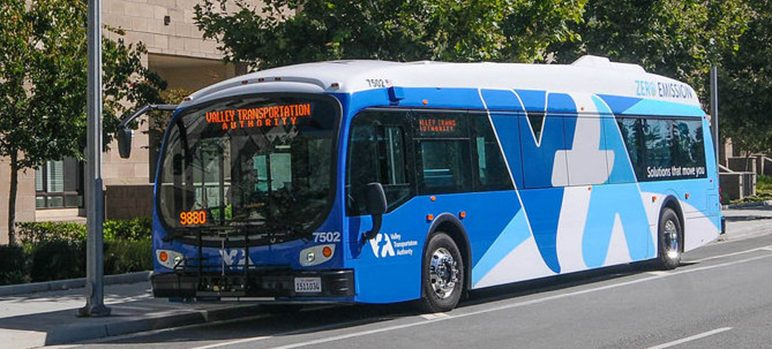The Santa Clara Valley Transportation Authority’s draft 10-year outlook for Measure B has received sharp criticism from South Bay city officials, who say the agency is going against the voters by allocating most of the funds away from street repair.
VTA staff, however, say the plan is in its early stages and nothing is set in stone.
Measure B, a 30-year, half-cent countywide sales tax, was approved by nearly 72 percent of county voters in 2016. Revenue from the tax, which is expected to generate $6.3 billion over its life, goes toward transportation projects.
The largest portions of revenue are expected to go toward street maintenance throughout the county and an expansion of BART from downtown San Jose to Santa Clara. BART funding is limited to 25 percent of the total revenue received from the tax.
Each city is allocated a portion of the funding annually for road improvement.
But members of the VTA’s Policy Advisory Committee on Nov. 12 rejected the agency’s draft 10-year plan when a spreadsheet showed that no funds would be allocated to local streets and roads through 2032. The bulk of the funding, meanwhile, was allocated to BART, with $661 million estimated in 2025.
Before the VTA’s board of directors meeting on Dec. 3, mayors from Cupertino, Los Altos, Los Gatos, Mountain View, Santa Clara and Sunnyvale submitted letters to the board in opposition to the draft plan.
Gilroy Mayor Marie Blankley, a committee member, said the prevailing focus on BART over the next decade is “unconscionable.”
“In Gilroy, if not all cities in Santa Clara County, the loss of annual Measure B revenue for the maintenance of our streets would be devastating,” she said. “The point of this 30-year sales tax increase was to have money that cities could plan for and count on to keep their streets from falling further and further into disrepair, among other transportation and congestion relief projects like Caltrain grade separations, highway interchanges, county expressways and the 85 corridor.”
Morgan Hill Mayor Rich Constantine, who chairs the countywide transportation committee, also opposed the draft plan. “I am a mayor of a city that is relying heavily on Measure B funds to fix our streets, fix our potholes,” he said. “That’s how I couched it when I asked my constituents to vote for Measure B.”
Marcella Rensi, VTA’s deputy director of grants and fund allocation, said the draft plan did not show allocations toward street maintenance because the board of directors has not yet allocated funds for it past 2021. She said the chart is only meant to begin the discussions on the 10-year plan that will continue over the next several months.
“This is simply an informational scenario,” she told the advisory committee on Nov. 12. “It is not a recommendation. There are no proposals in here. These blank lines should be treated as an opportunity to be filled out in the next few months.”
Although the item was for informational purposes only, the committee voted unanimously to decline it.
During the Dec. 3 meeting, where the draft plan was presented, VTA General Manager/CEO Nuria Fernandez reiterated that it was for discussion purposes only.
The Measure B budget for 2022 and 2023 is scheduled for consideration in May.



> Critics worry that too many of the funds are going to extend BART to Silicon Valley instead of repairing local streets.
YA THINK?
HELL YES!
VTA’s measure B shenanigans just the latest in a long pattern of wildly misspending taxpayer dollars. VTA is widely considered one of the worst transit agencies in the country.
https://www.opportunitynowsv.org/blog/how-vta-went-off-track-how-to-get-it-back-in-gear
Shut down the worthless and unridden Light Rail. It would save millions. Nothing like the feeling of being at a stoplight so that Light Rail can roll by, and counting zero people on the train. Consistently. My tax dollars at waste.
Lesson learned… never, ever vote for any additional tax headed for the VTA.
> Lesson learned… never, ever vote for any additional tax headed for the VTA.
Don’t be too hard on yourself.
We should probably blame your mother for not telling you.
Sanhoser Bubblehead, not me you idiot… I was referring to you!
John so true. or when your waiting to turn and you know that green arrow is his and will be skipped… Uhhhh
Shut down the worthless and unridden BART extension. It would save BILLIONS.
http://santaclaravta.iqm2.com/Citizens/FileOpen.aspx?Type=6&ID=1493 (slides 8&9)
They’ll just blame COVID for being off on their estimates of ridership by 16k people.
I’m sure if we look back we’d see the same ridiculous estimates for the Lightrail, doubt it’s ever hit even 10% of it’s original ridership estimates, though likely significantly higher costs than they ever projected.
The estimates allowed them to spend the millions and billions of dollars, they don’t actually have to guarantee they will ever accomplish that.
Just wait to see how much the ‘bullet trail’ to no where ends up costing the taxpayers to operate.
> Just wait to see how much the ‘bullet trail’ to no where ends up costing the taxpayers to operate.
At the rate Los Angeles is depopulating, there won’t be anyone there when they finally “finish” the bullet train in 2075.
It literally will be a “bullet train to nowhere”.
It looks like we need another tax.